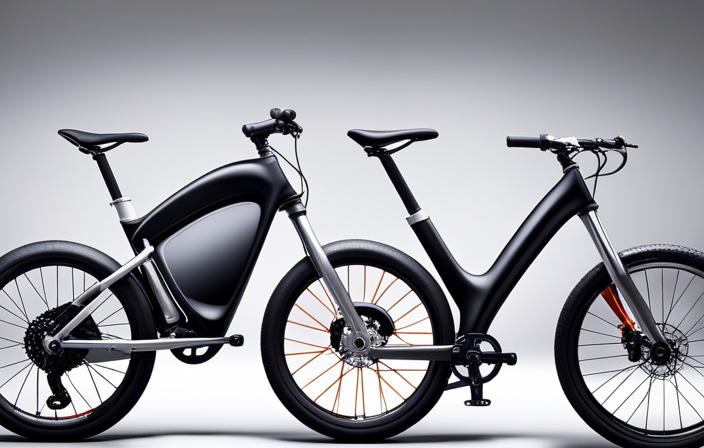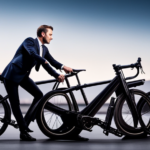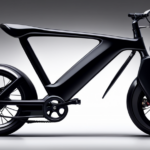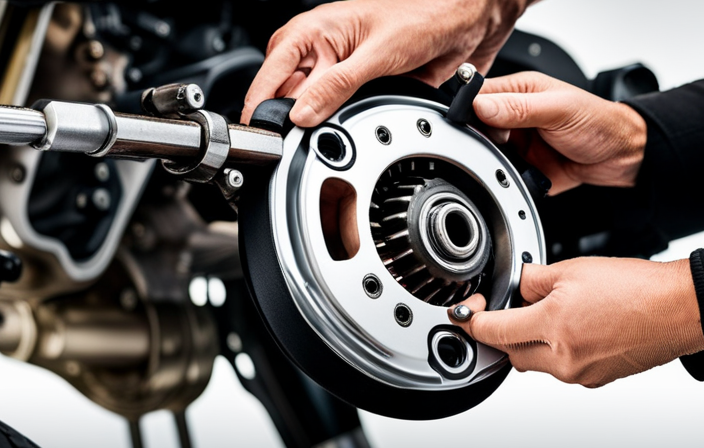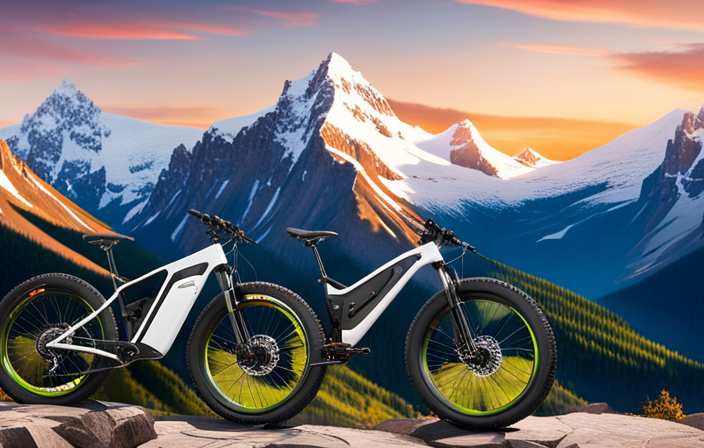One might argue that converting a regular bike into an electric powered bike is a complex and daunting task. However, with the right knowledge and tools, transforming your bike into an electric powerhouse can be a rewarding endeavor.
In this article, I will guide you through the step-by-step process of converting your bike into an electric powered vehicle. From assessing your bike’s suitability for conversion to installing the necessary components, I will provide you with the technical expertise needed to successfully complete this project.
Key Takeaways
- Choosing the right battery is crucial for optimal performance in electric bike conversion.
- Proper installation of the motor is necessary for a smooth and efficient ride.
- Programming the controller allows for fine-tuning of the electric bike’s performance.
- Following legal and regulatory requirements ensures the safety and legality of the electric bike on public roads and trails.
Assess Your Bike’s Suitability for Conversion
Assess if your bike is suitable for conversion by checking if it has a sturdy frame and enough space for a battery and motor. The bike frame is the foundation of the conversion process. It needs to support the additional weight and stress from the electric components. Look for a frame made of durable materials like steel or aluminum.
Additionally, consider the available space on the bike to accommodate the battery and motor. Measure the dimensions and ensure there’s enough room without compromising the bike’s balance and stability.
Once you’ve determined that your bike is suitable for conversion, you can proceed to gather the necessary tools and materials. This next step will require specific equipment and components to successfully transform your bike into an electric-powered machine.
Gather the Necessary Tools and Materials
To start, you’ll need a variety of tools and materials for this project. Here’s a list of what you’ll need:
-
Tools:
-
Wrench set
-
Screwdriver set
-
Wire cutters
-
Wire strippers
-
Multimeter
-
Soldering iron
-
Heat shrink tubing
-
Materials:
-
Electric bike conversion kit
-
Battery
-
Battery holder
-
Battery charger
-
Controller
-
Throttle
-
Wiring harness
Choosing the best battery is crucial for an efficient electric bike. Consider factors like voltage, capacity, and weight when selecting one. Proper wiring connections are essential to ensure a safe and reliable electric bike. Follow the instructions provided by the conversion kit manufacturer and make sure to secure all connections tightly and use appropriate insulation materials.
With the necessary tools and materials gathered, you can now move on to the next step of choosing the right electric bike conversion kit.
Choose the Right Electric Bike Conversion Kit
Selecting the appropriate electric bike conversion kit is essential for a successful project. There are several types of electric bike conversion kits available in the market, each with its own advantages and disadvantages. The most common types include front wheel, rear wheel, and mid-drive conversion kits.
Front wheel kits are easy to install and provide a balanced weight distribution, while rear wheel kits offer better traction and are suitable for off-road riding. Mid-drive kits provide a more natural riding experience and are ideal for hilly terrains.
The benefits of electric bike conversion are numerous. Firstly, it allows you to transform your regular bike into an electric one, saving you money compared to buying a new electric bike. Additionally, electric bikes are eco-friendly, producing zero emissions and reducing your carbon footprint. Electric bike conversion also provides a convenient mode of transportation, allowing you to effortlessly commute long distances without breaking a sweat.
Now that you have chosen the right electric bike conversion kit, it’s time to prepare your bike for the conversion process.
Prepare Your Bike for Conversion
Before starting the conversion process, it’s important to ensure that your bicycle is in good condition. Here are three key considerations to prepare your bike for conversion:
-
Assess the bike frame: Examine the frame for any damage or cracks that could affect the overall stability and safety of the electric bike. Reinforce weak areas if necessary to support the added weight of the conversion kit.
-
Choose the right battery placement: Determine the optimal location for the battery on your bike frame. Factors such as weight distribution, accessibility, and protection from external elements need to be taken into account. Mounting options include the downtube, seat tube, or rear rack.
-
Check compatibility: Verify that your bike’s components, such as brakes, gears, and wheel sizes, are compatible with the electric bike conversion kit. Make any necessary adjustments or upgrades before proceeding.
Having prepared your bike for conversion, it’s now time to move on to the next section and install the electric bike conversion kit seamlessly.
Install the Electric Bike Conversion Kit
Now that your bike is ready, it’s time to install the conversion kit and transform it into an electric bike.
The advantages of electric bike conversion are numerous. It allows you to enjoy the benefits of an electric bike without having to invest in a brand new one. Additionally, it gives you the flexibility to choose the components that suit your needs and preferences.
However, installing a conversion kit can present some challenges. One common issue is compatibility between the kit and your bike’s frame. It is crucial to ensure that the kit fits properly and securely. Another challenge is the complexity of the installation process, which may require technical expertise and specialized tools.
Once the kit is successfully installed, the next step is to connect the motor and battery, which will be discussed in the subsequent section.
Connect the Motor and Battery
To successfully connect the motor and battery, it’s important to follow the manufacturer’s instructions carefully. This ensures that the wiring and connections are made correctly, minimizing the risk of any electrical issues. When connecting the components, it’s crucial to identify the correct wires and connectors, as mismatched connections can lead to damage or malfunction. To assist with this process, refer to the included instruction manual or diagram provided by the manufacturer. Additionally, it is recommended to use appropriate tools, such as wire strippers and crimpers, to ensure secure connections. Once the motor and battery are properly connected, it’s time to install the throttle and controller, which will be covered in the subsequent section. With the motor and battery connected, the electric bike conversion kit is one step closer to completion.
Install the Throttle and Controller
Start by carefully following the manufacturer’s instructions to install the throttle and controller on your electric bike conversion kit.
When installing the throttle, make sure to mount it securely on the handlebars, within easy reach of your thumb.
Connect the throttle wires to the corresponding wires on the controller, ensuring a tight and secure connection.
It is important to double-check all the connections and ensure that they are properly insulated to avoid any potential electrical issues.
If you encounter any problems during the installation process, refer to the controller troubleshooting techniques provided by the manufacturer.
Once the throttle and controller are installed, you can proceed to the next step of testing the electric bike conversion.
Test the Electric Bike Conversion
After installing the throttle and controller, it’s important to test the electric bike conversion to ensure its proper functioning. Here are four key testing methods for a thorough performance evaluation:
-
Speed Test: Measure the top speed of the electric bike on different terrains to assess its acceleration and overall performance.
-
Range Test: Determine the maximum distance the bike can travel on a single charge to evaluate its battery efficiency and estimate the riding range.
-
Hill Climb Test: Ascend various inclines to assess the motor’s power and torque capabilities, ensuring it can handle different gradients.
-
Braking Test: Evaluate the responsiveness and effectiveness of the electric bike’s braking system to ensure safety during rides.
Once the electric bike conversion passes these tests, we can proceed to the next section and fine-tune its performance for optimal riding experience.
Adjust and Fine-Tune the Electric Bike
Once the electric bike conversion has been successfully tested, I can proceed to fine-tune its performance for an optimal riding experience. Fine tuning techniques involve adjusting various components to achieve the desired speed, power, and efficiency. One important aspect is tweaking the controller settings to find the right balance between acceleration and battery life. Additionally, I can fine-tune the pedal assist sensor sensitivity to ensure smooth and seamless transitions between electric and manual power. Troubleshooting tips are also crucial during this phase, as they help identify and address any potential issues that may arise. By carefully analyzing the performance data and making necessary adjustments, I can ensure that the electric bike operates at its peak performance. With the fine-tuning complete, it’s time to move on and learn proper charging and maintenance techniques to keep the electric bike in top condition.
Learn Proper Charging and Maintenance
To ensure optimal performance and longevity, it’s important to learn the proper charging and maintenance techniques for the electric bike.
Charging efficiency plays a crucial role in maximizing the battery life and overall performance of the bike. It is recommended to use the charger provided by the manufacturer and avoid using third-party chargers, as they may not provide the necessary voltage and current levels.
Additionally, it is essential to follow the recommended charging time and avoid overcharging the battery, as it can negatively impact its lifespan.
As for maintenance, creating a regular maintenance schedule is vital. This includes checking the tire pressure, inspecting the brakes, lubricating the chain, and tightening any loose bolts.
By following these charging and maintenance practices, you can enjoy the benefits of an electric bike without compromising its performance or longevity.
Enjoy the Benefits of an Electric Bike
You can fully experience the advantages of an e-bike by incorporating it into your daily commute or leisure activities. Here are some benefits of electric bikes:
-
Effortless Riding: With an electric bike, you can effortlessly cover long distances and conquer steep hills without breaking a sweat.
-
Eco-Friendly: Electric bikes are a greener alternative to traditional bikes or cars, as they produce zero emissions and reduce your carbon footprint.
-
Cost-Effective: Compared to cars or motorcycles, electric bikes are more affordable to purchase and maintain, saving you money on fuel, insurance, and parking fees.
-
Health Benefits: Contrary to popular belief, electric bikes still require pedaling, providing a low-impact form of exercise that improves cardiovascular health and promotes overall fitness.
By enjoying the numerous benefits of an electric bike, you can enhance your daily commute or leisure activities. Ensure your safety by following the guidelines for riding in the subsequent section.
Stay Safe While Riding
Staying safe while riding an e-bike is essential for a worry-free and enjoyable experience. When it comes to bike safety, there are a few riding tips to keep in mind.
First and foremost, always wear a helmet to protect your head in case of a fall or collision. Additionally, make sure to obey traffic laws and signals, just like you would while driving a car. Stay visible to other road users by wearing bright clothing and using reflectors on your bike. It’s also important to be aware of your surroundings and anticipate potential hazards. Lastly, maintain a safe speed and avoid sudden maneuvers that could cause loss of control.
By following these bike safety guidelines, you can enjoy your electric bike with peace of mind.
Transitioning to the next section, it’s also crucial to consider legal and regulatory requirements.
Consider Legal and Regulatory Requirements
When it comes to modifying a bicycle to be electric powered, it is important to not only focus on the technical aspects but also consider the legal and regulatory requirements.
Legal compliance is crucial to ensure that your electric bike is safe and legal to use on public roads and trails. Different jurisdictions may have specific rules and regulations regarding the use of electric bikes, including speed limits, power output limits, and age restrictions. It is essential to familiarize yourself with these requirements to avoid any legal issues or penalties.
Additionally, safety standards must be taken into account to ensure that your electric bike is built with proper components and meets safety guidelines. By adhering to legal and safety requirements, you can enjoy the benefits of an electric bike while minimizing any potential risks.
Now, let’s explore additional upgrades and accessories to enhance your electric bike experience.
Explore Additional Upgrades and Accessories
To further enhance your e-biking experience, there are various upgrades and accessories available for you to explore.
One important upgrade is to improve your braking system. Upgrading your brakes will allow for better stopping power and increased safety while riding. Consider upgrading to hydraulic disc brakes, which provide superior stopping performance compared to traditional mechanical brakes.
Additionally, adding lights to your electric bike is crucial for visibility, especially when riding in low light conditions or at night. Install front and rear lights that are bright and have different modes to suit your needs.
These upgrades will not only make your e-bike safer but also improve your overall riding experience.
In the next section, I will share my electric bike conversion experience and provide tips for a successful conversion.
Share Your Electric Bike Conversion Experience
Sharing my experience converting a regular bike into an e-bike was a rewarding and exciting process. As I delved into the world of electric bike conversion, I encountered several challenges and learned useful tips along the way. Here are three key points to consider when embarking on an electric bike conversion:
-
Battery selection: Choosing the right battery is crucial for optimal performance. Consider factors such as capacity, voltage, and weight to ensure a balance between power and range.
-
Motor installation: Properly installing the motor is essential for a smooth and efficient ride. Pay attention to the alignment, wiring, and compatibility with your bike frame to avoid future issues.
-
Controller programming: Programming the controller allows you to fine-tune the performance of your e-bike. Understanding the different settings and adjusting parameters like speed limits and assist levels can greatly enhance your riding experience.
Converting a regular bike into an electric one may present challenges, but with careful planning and attention to detail, it can be a rewarding project.
Frequently Asked Questions
How much does it cost to convert a bike to electric power?
Converting a bike to electric power can cost between $500-$2000, depending on the components used. However, the benefits of electric power, such as increased speed and reduced effort, justify the cost comparison.
Are there any weight limitations for converting a bike to electric power?
Weight limitations for electric bike conversion depend on the specific components used. Safety concerns arise when converting heavy bikes, as it can affect stability and handling. It is crucial to consider the bike’s frame strength and the weight capacity of the motor and battery.
Can I still pedal the bike after converting it to electric power?
Yes, you can still pedal the bike after converting it to electric power. However, there are pros and cons to consider. While it allows for a smoother ride and reduces impact on the environment, it also adds weight and may limit your range.
How long does it take to charge the battery?
The charging time of the battery depends on its capacity. A higher capacity battery will take longer to charge. It is important to consider the battery capacity when determining the charging time for an electric bike.
Are there any restrictions on where I can ride my electric bike?
There are some regulations regarding where electric bikes can be ridden, such as public road restrictions and bike lane regulations. It is important to be aware of these rules to ensure a safe and legal riding experience.
Conclusion
In conclusion, converting my bike into an electric-powered machine was a game-changer. With the right tools and materials, I was able to transform my ordinary bike into a powerful and efficient means of transportation.
The electric bike conversion kit I chose provided the perfect balance of speed and control. As I effortlessly cruised through the streets, it felt like I had unleashed a hidden superpower.
Just like a caterpillar transforming into a butterfly, my bike underwent a remarkable metamorphosis, allowing me to soar through the city with ease.
Don’t miss out on this electrifying experience!

